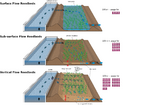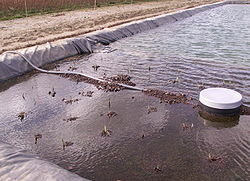A treatment pond is an extremely simple bioreactor for treating wastewater, being simply a pond with bacteria from the environment and the wastewater performing the treatment. The bacterial concentration is low compared to other biological treatment processes such as activated sludge.
The wastewater may contain organic toxins, sediment, and/or anaerobic bacteria. The organic fraction of the wastewater is converted by the bacteria, producing solids, carbon dioxide and water. Solids produced this way, along with the bacterial solids, settle out due to the very slow movement of water in the shallow ponds.
Role of treatment ponds
Treatment ponds are used for agricultural waste, and sometimes as part of the processing of waste from food production. Industrial liquid wastes may be suitable, if there is organic content, but at a low concentration where other forms of biological treatment are inefficient.
They may also treat polluted stormwater.
Depending on the quality of the output, it may be suitable as fertilizer and irrigation water.
A treatment pond may be used in combination with a rainwater reservoir to form a self-purifying irrigation reservoir or swimming pond.[1][2] Small-scale treatment can be done in small pond if the effluent is given adequate time to break down the wastewater. Smaller ponds may need to be divided in a similar way to septic tanks.
Constructed wetlands
A constructed wetland is a kind of treatment pond with an emphasis on supporting a complex ecosystem within and around the ponds.
Design
Three types of reedbed

There are three kinds of reedbed setups. They can be used in commercial systems (usually with septic tanks).[3] They are:
- Surface flow (SF) reedbeds
- Subsurface Flow (SSF) reedbeds
- Vertical Flow (VF) reedbeds
The reedbeds grow in a closed basin with a substrate medium. For most commercial purposes, ponds are lined in order to be watertight. Rubber can be used. Preventing leakage is essential in urban areas or close to residences. Substrate medium can be gravel, sand and/or lavastone.

In surface flow reedbeds a horizontal flow carries waste water between the plant roots. They are used much less in recent years, as they need a large area area, around 20 m2 per person for domestic wastewater. In cold weather smell and poorer purification are problems.[4]
In subsurface flow reedbeds, wastewater flows between plant roots below the water surface. This is more efficient, requiring 5–10 m2 per person. There is less smell and less sensitivity to cold or winter conditions. Clogging intakes are a potential problem.[4]
Vertical flow reedbeds are similar to subsurface flow reedbeds, and they have similar advantages in efficiency (only 3 m2 is needed per person.[4]) and cold-weather tolerance. Wastewater flow is vertical, aided by a pump from the bottom.[verification needed] Vertical reedbeds generally use a fine sand to allow greater bacterial concentration. Oxygenation of the water is better.[verification needed] Pulsed pumping reduces obstructions in the intakes.
Organisms
Usually, common reed or Phragmites australis are used in treatment ponds (e.g., in greywater treatment systems to purify wastewater). In self-purifying water reservoirs(used to purify rainwater), other plants are used as well. These reservoirs need to be filled with 1/4 lavastones and water-purifying plants.[5]
Treatment ponds use a wide variety of plants, depending on the local climate and other conditions. Plants are generally chosen which are indigenous, for environmental reasons and optimum performance. In addition to water purifying (de-nutrifying) plants, plants that supply oxygen, and shade are added in ecological water catchments, ponds. This allows a complete ecosystem. Local bacteria and non-predatory fish may be added to eliminate pests. The bacteria are usually grown by submerging straw in water and allowing bacteria from the surrounding air to form on it. Plants are divided in four water depth-zones:
- A water depth from 0–20 cm. Iris pseudacorus, Sparganium erectum may be placed here (temperate climates).
- A water depth from 40–60 cm. Stratiotes aloides, Hydrocharis morsus-ranae may be placed here (temperate climates).
- A water depth from 60–120 cm. Nymphea alba, may be placed here (temperate climates).
- A submerged water depth. Myriophyllum spicatum may be placed here (temperate climates).
Three non-predatory fish (surface, bottom and ground-swimmers) are chosen. This ensures the fish 'get along'. Examples for temperate climates are:
- Surface swimming fish: Leuciscus leuciscus, Leuciscus idus, and Scardinius erythrophthalmus
- Middle-swimmers: Rutilus rutilus
- Bottom-swimming fish: Tinca tinca
The plants are usually grown on coconut fibre.[6] At the time of implantation to water-purifying ponds, de-nutrified soil is used to prevent growth of algae and other unwanted organisms
Finishing
These systems, for example, aerate the water after the final reedbed using cascades such as flowforms before holding the water in a shallow pond.[7] Primary treatments such as septic tanks, and pumps such as grinder pumps may be added.[8]
Rooftop treatment ponds
Rooftop water purifying ponds are being used on rooftops. These green roofs can be built from a simple substrate (as is being done in Dongtan)[9] or with plant-based ponds (as is being done by WaterWorks UK Grow System).[10] Waterzuiveren.be[11] Plants used include calamus, Menyanthes trifoliata, Mentha aquatica, ...[12]
See also
Interwiki links
External links
References
Template:Cleanup-link rot Template:Reflist
- ↑ Ecologic water basins used for agriculture/irrigation
- ↑ reservoirs made self-purifying through addition of treatment pond
- ↑ reedbed descriptions
- ↑ 4.0 4.1 4.2 reedbed secriptions
- ↑ Overview of lavafilters
- ↑ Coconut growing medium used for water purifying plants
- ↑ [1] reedbed and flowform cascade polishing, Sheepdrove Organic Farm, England
- ↑ Pictures of hybrid reedbed systems
- ↑ Dongtan green roofs filter water
- ↑ WWUK rooftop water purification with plants
- ↑ Waterzuiveren.be building water-purifying roofponds
- ↑ Description of plants used in water-purifying rooftop ponds